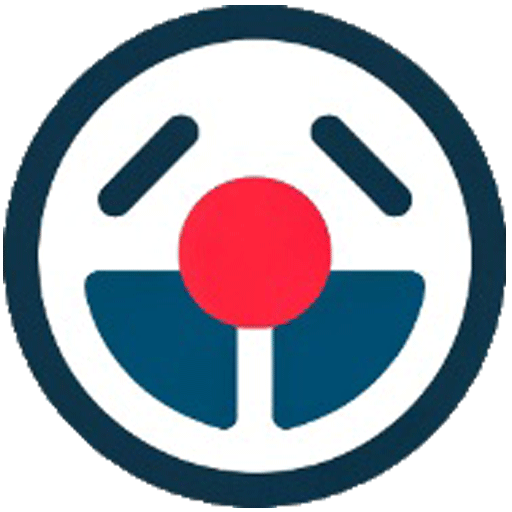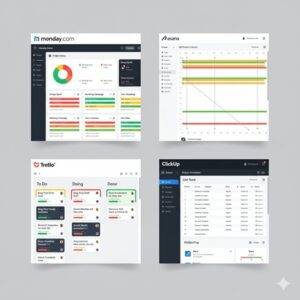Introduction: Best Project Management Tools
I remember the exact moment I knew spreadsheets wouldn’t cut it anymore. It was 2019, and I was juggling three major client projects with a newly remote team scattered across two continents. A critical file went missing, a deadline was blown because of a missed Slack message, and my “master” spreadsheet was a graveyard of conflicting information. The stress was immense. That chaos was the catalyst for my deep dive into the world of project management software—a journey that transformed not just my productivity, but my entire business.
If you’re a leader of a remote team, that story probably sounds painfully familiar. The freedom of remote work is incredible, but without the right infrastructure, it descends into digital chaos. You need a central source of truth, a digital headquarters that keeps everyone aligned, accountable, and moving forward.
You’ve come to the right place. I’ve spent years in the trenches, testing, implementing, and optimizing these tools for various remote teams. This isn’t just a list of features copied from a pricing page. This is a battle-tested guide designed to help you make an informed decision and reclaim your team’s sanity. Let’s dive in.
Why Your Remote Team Needs More Than Just Slack and Email
Without a dedicated project management (PM) tool, remote teams operate with invisible friction. Key challenges include:
- Lack of Visibility: It’s impossible to see who is working on what, what the priorities are, and where bottlenecks are forming.
- Communication Silos: Important conversations and decisions get buried in endless Slack threads or email chains, disconnected from the actual work.
- No Accountability: When tasks are assigned verbally or through chat, it’s easy for things to fall through the cracks. A PM tool creates a clear record of ownership and deadlines.
- Wasted Time: Teams waste countless hours searching for information, asking for status updates, and duplicating work.
A good PM tool isn’t just another piece of software; it’s the central nervous system for a high-performing remote team.
How We Chose the Best Project Management Tools for This Review
To make this list, a tool had to excel in areas crucial for remote collaboration. My criteria were simple but strict:
- Remote-First Features: Did it offer robust time tracking, versatile communication integrations (Slack, Teams, etc.), and clear reporting dashboards?
- Ease of Use: Could a non-technical team member get up and running quickly?
- Scalability: Can the tool grow with your team, from a 3-person startup to a 30-person agency?
- Value for Money: Does the price justify the features offered, especially for small to medium-sized businesses?
I personally used each of these tools for real projects. Here’s the breakdown.
The 4 Best Project Management Tools for Remote Teams (In-Depth Review)
1. Monday.com: The Visual Powerhouse for Agile Teams
- Best for: Creative agencies, marketing teams, and any team that thrives on visual workflows and dashboards.
- My Personal Take: I once managed a complex product launch for a design agency using Monday.com. The ability to create a high-level dashboard with color-coded statuses was a game-changer. The client could log in, see the ‘At a Glance’ board, and get a complete status update without ever sending an email. It saved us hours of meetings every single week.
- Key Remote Features:
- Customizable Dashboards: Build high-level views to track KPIs, project progress, and team workload in real-time. Essential for remote managers needing a quick overview.
- Automations: Automate repetitive tasks like moving a card when a status changes or notifying a team member when a deadline is approaching.
- Integrations: Deep integration with tools like Slack, Adobe Creative Cloud, and Mailchimp makes it a seamless hub for creative and marketing work.
- Pricing: Starts with a free plan for individuals. Paid plans begin at around $9/user/month.
- Pros & Cons:
- Pros: Highly visual and intuitive, incredibly flexible, powerful automation and reporting.
- Cons: Can be overwhelming to set up initially, per-user pricing can get expensive for larger teams.
- Verdict: If your team thinks visually and you need powerful, at-a-glance reporting to keep everyone (including clients) in the loop, Monday.com is an outstanding investment.
👉 Try Monday.com for free and see how its visual dashboards can transform your team’s workflow.
2. Asana: The Goal-Oriented Choice for Structured Workflows
- Best for: Product management, engineering teams, and businesses that need to connect daily tasks to strategic goals.
- My Personal Take: For my own content business, Asana is the backbone. I use its Timeline view to plan my entire quarterly content calendar like a Gantt chart. The Portfolios feature lets me group different projects (Blog, YouTube, Newsletter) and track their overall progress against my business goals. It forces clarity and structure, which is vital when you’re managing dozens of moving pieces remotely.
- Key Remote Features:
- Timeline View: A beautiful and functional Gantt chart alternative that makes it easy to map out project dependencies and timelines.
- Workload Management: See how much work is on each team member’s plate to prevent burnout and reallocate resources effectively—a must-have for remote managers.
- Goals: Cascade company-wide objectives down to individual tasks, ensuring everyone’s work is contributing to the bigger picture.
- Pricing: Robust free plan for up to 15 users. Paid plans start at $10.99/user/month.
- Pros & Cons:
- Pros: Excellent for goal tracking and structured projects, powerful task management, clean and professional interface.
- Cons: Less visually flexible than Monday.com, can feel a bit rigid for purely creative brainstorming.
- Verdict: For remote teams that need structure, accountability, and a clear line of sight from tasks to goals, Asana is the undisputed champion.
👉 Start organizing your team’s work and hitting your goals with Asana’s powerful free plan.
3. Trello: The Simple & Intuitive Kanban King
- Best for: Small teams, startups, freelancers, and anyone who wants a simple, no-fuss tool for organizing tasks.
- My Personal Take: Trello was the first PM tool I ever used seriously. When I was starting out as a one-person business, a simple Trello board was my entire content calendar and sales pipeline. Its simplicity is its superpower. You can explain how to use it in 60 seconds. For a small remote team that needs to get organized today without a steep learning curve, Trello is perfect.
- Key Remote Features:
- Kanban Boards: The simple drag-and-drop card system is intuitive and provides an instant visual status of every task.
- Power-Ups: Enhance your boards with integrations for time tracking, calendars, Slack, Google Drive, and more, adding functionality as you need it.
- Simplicity: The learning curve is practically zero, which means your team will actually use it. Adoption is the biggest hurdle for any new software.
- Pricing: An excellent free plan with unlimited cards and up to 10 boards. Paid plans with more features start at $5/user/month.
- Pros & Cons:
- Pros: Incredibly easy to use, great free plan, highly visual and satisfying to use.
- Cons: Can become cluttered on complex projects, lacks the advanced reporting and workload management of Asana or Monday.
- Verdict: If you’re overwhelmed by complexity and just need a simple, visual way to see who’s doing what, start with Trello. It’s the easiest path from chaos to clarity.
👉 Get started with Trello’s free plan in minutes and bring visual order to your team’s projects.
4. ClickUp: The “One App to Replace Them All”
- Best for: Tech-savvy teams, power users, and businesses that want to consolidate tasks, docs, goals, and spreadsheets into a single platform.
- My Personal Take: I’ll be honest, my first attempt at using ClickUp was overwhelming. But I gave it a second try, and once I understood its hierarchical structure, it clicked. I was able to replace Trello, Google Docs, and a separate goal-tracking app with ClickUp alone. It has the most customizable feature set I’ve ever seen, which is a double-edged sword: a dream for tinkerers, but potentially a nightmare for teams wanting simplicity.
- Key Remote Features:
- Multiple Views: Switch between List, Board, Calendar, Gantt, and more with a single click. Every team member can view the work in the way that makes sense to them.
- Built-in Docs: Create project briefs, wikis, and notes right alongside your tasks, eliminating the need to jump between apps.
- Everything View: A powerful feature for managers to see all tasks from all projects across the entire organization in one place.
- Pricing: A feature-rich free plan. Paid plans are aggressively priced, starting at $7/user/month.
- Pros & Cons:
- Pros: Unbeatable number of features for the price, highly customizable, consolidates many tools into one.
- Cons: Can have a steep learning curve, the sheer number of options can lead to decision fatigue.
- Verdict: If your remote team is frustrated by juggling multiple apps and you’re willing to invest a little time in setup, ClickUp can become an incredibly powerful, all-in-one workspace.
👉 Explore ClickUp’s all-in-one platform and see if it’s the right fit for your power-user team.
Quick Comparison Table for Remote Teams
Conclusion: The Best Tool is the One Your Team Will Actually Use
There is no single “best” project management tool. The best tool is the one that fits your team’s unique culture and workflow.
- Choose Monday.com if you need beautiful, high-level visual reports.
- Choose Asana if you need structure and to connect daily work to big-picture goals.
- Choose Trello if you need simplicity and quick adoption above all else.
- Choose ClickUp if you want ultimate power and a single home for all your work.
My advice? Sign up for the free trials of your top two contenders. Run a small, real-world project on each. See which one feels more natural for your team. A tool that gets used imperfectly is infinitely better than a “perfect” tool that gathers digital dust.
You have the power to end the remote work chaos. Pick a tool, commit to it, and watch your team’s productivity and morale soar.
Frequently Asked Questions (FAQ)
-
Q1: What’s better for a small remote team, Asana or Trello?
- For most small teams just starting, Trello is often the better choice. Its simplicity and visual Kanban board make it incredibly easy to adopt. If your team needs more structure, dependency management, or to track tasks against larger goals, then Asana is the more powerful option.
-
Q2: Are there any good free project management tools for personal use or small teams?
- Absolutely. Trello, Asana, and ClickUp all have excellent free-forever plans that are very generous. For most small teams or individuals, these free plans are more than powerful enough to get started and stay organized.
-
Q3: How do these tools help improve remote team productivity?
- They create a single source of truth, reducing time spent searching for information. They clarify who is responsible for what and by when, increasing accountability. They provide visibility into workloads, helping managers prevent burnout. Finally, they automate repetitive tasks, freeing up your team to do more meaningful work.
Hi, I’m [jeybee]. As a long-time resident of Seoul, I’m passionate about uncovering the authentic, everyday magic of Korea. This blog is my way of sharing my favorite spots, tips, and cultural insights with you, beyond the usual tourist traps.



